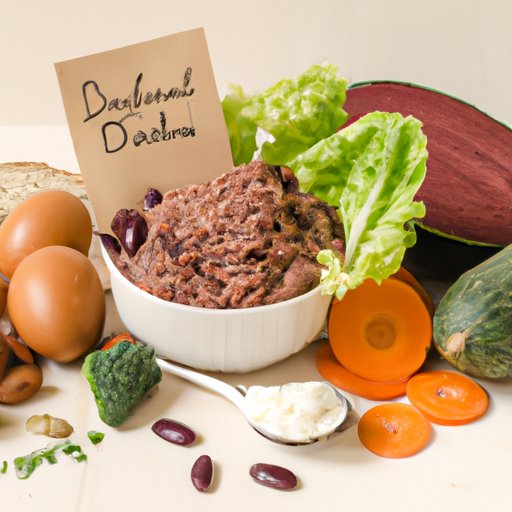
I. Introduction
The Pegan diet is a relatively new approach to healthy eating that combines the best aspects of the Paleo and Vegan diets. By incorporating both principles, the Pegan diet emphasizes whole, nutrient-dense foods while reducing the intake of animal products, processed foods, and sugars. The purpose of this article is to explore the benefits of the Pegan diet and provide a comprehensive guide to implementing it in your own life.

II. Going Pegan: How to Blend Paleo and Vegan for Optimal Health
The Paleo diet is centered around the idea of eating like our ancestors, consuming whole foods such as meat, fish, vegetables, and fruits while avoiding grains, dairy, and processed foods. On the other hand, the Vegan diet excludes all animal products and promotes plant-based eating. The Pegan diet combines the two by allowing small amounts of high-quality meat or fish while mainly emphasizing plant-based foods.
Advantages of the Pegan diet include decreased inflammation, improved digestion, and increased energy levels. To implement the Pegan diet, focus on consuming primarily plant-based foods, including vegetables, fruits, nuts, and seeds. Additionally, include high-quality protein sources such as grass-fed meat and wild-caught fish in moderation. Avoid processed foods, sugars, and refined oils.
III. The Best of Both Worlds: Exploring the Benefits of the Pegan Diet
One of the main nutritional benefits of the Pegan diet is its emphasis on whole, nutrient-dense foods. By consuming a variety of plants, dieters can ensure they are receiving a range of vitamins, minerals, and antioxidants necessary for optimal health. Additionally, the Pegan diet may lower the risk of chronic diseases such as heart disease, diabetes, and cancer.
The Pegan diet also has health benefits, including improved digestion, increased energy levels, and decreased inflammation. Reduced inflammation can lead to improved brain function and a decreased risk of chronic diseases associated with inflammation, such as arthritis and Alzheimer’s disease. Furthermore, the Pegan diet is environmentally friendly, as it promotes plant-based eating and limits the consumption of animal products.
IV. Peganism: A New Take on Healthy Eating
The Pegan diet was developed by Dr. Mark Hyman, a physician and functional medicine practitioner. Dr. Hyman recognized the benefits of both the Paleo and Vegan diets but also recognized that both had limitations. By combining the two, he created a diet that emphasizes whole, nutrient-dense foods while limiting the intake of processed foods and animal products.
Key principles of the Pegan diet include consuming primarily plant-based foods while including high-quality protein sources, avoiding gluten and dairy, and limiting processed foods, sugars, and refined oils. Examples of Pegan-friendly foods include vegetables, fruits, nuts, seeds, grass-fed meat, and wild-caught fish. Pegan-friendly recipes include meals such as vegetable stir-fries, lentil soup, and grilled salmon with roasted vegetables.
V. From Cavemen to Compassion: The Evolution of the Pegan Diet
The Paleo diet is based on the idea of eating like our ancestors, who consumed whole, unprocessed foods. The Vegan diet is centered around compassion for animal life and the promotion of plant-based eating. The Pegan diet builds on these concepts by emphasizing whole, nutrient-dense foods while limiting the intake of animal products. The Pegan diet is a more compassionate approach to healthy eating that recognizes the value of plant-based eating while still allowing for small amounts of high-quality animal products.
The future of the Pegan diet is bright as more people recognize the benefits of consuming whole, nutrient-dense foods while limiting the intake of animal products. The Pegan diet is an inclusive diet that can be adapted to a variety of dietary restrictions, making it accessible to a wide range of individuals.
VI. Peganism versus Paleo and Veganism: Which is Better for You?
While the Paleo and Vegan diets are both popular approaches to healthy eating, they have limitations. The Paleo diet may lack fiber and can be expensive due to its emphasis on high-quality animal products. The Vegan diet may be deficient in certain nutrients and protein if not carefully planned.
The Pegan diet is a middle ground that allows for high-quality animal products in moderation while mainly promoting plant-based eating. When choosing a diet, consider your individual dietary needs, lifestyle, and values. The Pegan diet may be the best fit for individuals seeking a more balanced approach to healthy eating.
VII. The Pegan Diet: A Comprehensive Guide to Combining Vegan and Paleo Principles
The Pegan diet emphasizes whole, nutrient-dense foods while limiting the intake of animal products, processed foods, and refined oils. To follow the Pegan diet, consume primarily plant-based foods, including vegetables, fruits, nuts, and seeds. Include high-quality protein sources such as grass-fed meat and wild-caught fish in moderation. Avoid gluten, dairy, sugars, and processed foods.
Sample meal plans for the Pegan diet may include meals such as a vegetable stir-fry with quinoa, avocado toast with smoked salmon, and a spinach and mushroom omelet with sweet potato hash. Customizing the diet to fit individual needs may include reducing the intake of animal products or incorporating more protein-rich plant-based foods.
VIII. Why the Pegan Diet is Gaining Popularity in the Health and Fitness World
The Pegan diet has gained popularity in the health and fitness world due to its emphasis on whole, nutrient-dense foods while limiting the intake of processed foods and animal products. The Pegan diet is environmentally friendly and may improve digestion, increase energy levels, and decrease inflammation.
Media coverage of the Pegan diet has brought attention to its benefits, and testimonials from Pegan dieters have shown significant improvements in overall health. Furthermore, the Pegan diet is beneficial for athletes and fitness enthusiasts due to its emphasis on high-quality protein sources.
IX. Conclusion
The Pegan diet is a balanced approach to healthy eating that combines the best aspects of the Paleo and Vegan diets. By emphasizing whole, nutrient-dense foods while limiting the intake of animal products and processed foods, individuals can improve their overall health and wellbeing. The Pegan diet is inclusive and customizable, making it accessible to a wide range of individuals seeking a more balanced approach to healthy eating.
Try implementing the Pegan diet in your own life by consuming primarily plant-based foods while including high-quality protein sources in moderation. Avoid processed foods, sugars, and refined oils, and customize the diet to fit your individual needs. By choosing the Pegan diet, you can improve your overall health and wellbeing while contributing to a more sustainable future for our planet.





